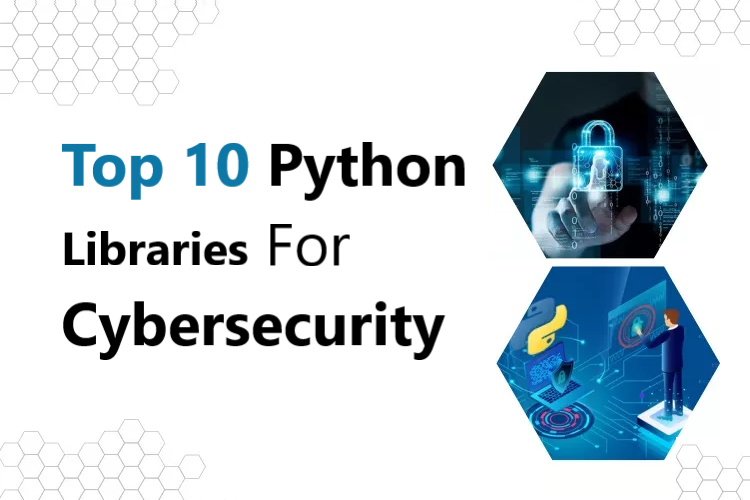Cyber threats are increasing at an alarming rate. Hardly a day goes by without hearing about a new data breach or cyber attack in the news. Cybersecurity is no longer just an IT problem – it is now a critical business risk that organizations must manage carefully.
In this climate, companies need intelligent security systems that can automatically detect and respond to emerging threats. This is where Python comes into play.
Python has become the go-to programming language for developing cybersecurity applications thanks to its versatility and extensive selection of security-focused libraries. Python empowers developers to quickly build sophisticated security tools that safeguard infrastructure and data.
In this post, we will explore some of the most useful Python libraries for cybersecurity that allow you to leverage the language’s capabilities. Whether you are a security engineer, researcher, analyst or hobbyist, these Python libraries can help you stay on top of the ever-evolving threat landscape.
First, we will look at why Python has become so ubiquitous in cybersecurity. Then, we will highlight 10 awesome libraries that make Python a preferred language for building robust security solutions.
Why is Python used in Cybersecurity?
Before jumping into the libraries, let’s first understand why Python has become so popular in the information security domain.
- Easy to Learn
Python has a very gentle learning curve. The syntax is intuitive and easy to read even for beginners. You do not need to be an expert coder to start building security tools in Python. This makes it easy for cybersecurity professionals from various backgrounds to pick up Python.
- Vast Libraries
Python has some of the best libraries for all sorts of cybersecurity tasks. We will discuss the top 10 below. The availability of these libraries makes it easy to get started with Python for infosec.
- Cross-platform
Python runs on all major platforms like Windows, Linux and macOS. This cross-platform availability makes Python an ideal language for cybersecurity tools that need to run across various operating systems.
- Speed of Scripting
Python being an interpreted language makes the process of writing and executing scripts very fast. Infosec professionals can use Python to quickly write scripts, test proof of concepts or prototyping tools.
- Active Community
Python has an active community and resources online. This is useful when you are stuck on a problem or need help with using a particular library. The abundance of documentation and help available allows faster development cycles.
Top 10 Python Libraries for Cybersecurity
Now let’s look at some of the most popular and powerful Python libraries used by cybersecurity professionals and ethical hackers today.
Scapy
Scapy is a powerful Python library used for crafting and dissecting network packets. It can be used to build network security tools like network sniffers, probes, packet manipulators etc.
Some uses of Scapy include:
- Building network scanners to identify live hosts, open ports, OS fingerprinting etc.
- Crafting customized network packets to test firewall rules and intrusion detection systems.
- Analyzing pcap files and intercepting packets.
- Building packet sniffers and network protocol analyzers.
- Fuzzing network applications using malformed packets.
- Conducting penetration testing tasks like port scanning, banner grabbing etc.
Scapy’s key capability is the ability to dissect packets at different protocol layers and then modify and reassemble them for transmission. This makes it a very powerful tool for offensive as well as defensive security testing.
PyCrypto
PyCrypto is Python’s premier library for cryptographic functions like encryption, decryption, hashing etc. It can be used to add security to Python applications and implement cybersecurity algorithms.
Some example uses of PyCrypto include:
- Encrypting and decrypting data using symmetric/asymmetric algorithms like AES, RSA etc.
- Generating digital certificates and signatures to implement authentication.
- Calculating message digests and checksums using hash functions like MD5, SHA256 etc.
- Performing other cryptographic operations like encoding, key generation and exchange etc.
PyCrypto provides a collection of robust cryptographic primitives necessary for building security applications. It is a low level library that can be used as the foundation for higher level security tools.
REQUESTS
REQUESTS is an elegant Python library used for making HTTP requests to webservers. It abstracts a lot of complexities of making web requests behind a simple API.
Some cybersecurity use cases of the REQUESTS module are:
- Building web vulnerability scanners to look for issues like XSS, SQLi etc.
- Writing fuzzers for web applications using techniques like parameter manipulation.
- Sending specially crafted HTTP requests to identify weaknesses in web apps.
- Crawling and scraping content from websites to gather information.
- Automating penetration testing tasks like authorization bypass, command injection on web apps.
- Developing automated web monitoring tools to identify anomalies in traffic.
The REQUESTS module makes the whole process of making different types of HTTP calls very simple. It also handles sessions, cookies, connections, proxies etc. behind the scenes.
BeautifulSoup
BeautifulSoup is a popular Python library used for parsing and extracting information from HTML and XML files. It can be used for web scraping, extraction of metadata from documents etc.
Some common uses in security are:
- Web scrapers can use BeautifulSoup to extract links, forms, data etc. from web apps. This is useful for reconnaissance and gathering information from websites.
- It can help parse human-readable reports like Nessus scan reports or Burp XML output and convert into JSON/CSV format for automation.
- Security tools can use BeautifulSoup to parse XML/HTML responses returned by servers and APIs to extract relevant information.
- Helps parse logs and packets containing human readable data like HTTP headers, XML payload etc.
- Data extraction from document files like DOCX, XLSX and PDFs for forensic investigation.
BeautifulSoup’s simple API to navigate through complex HTML/XML data makes it very useful for security analysts and tool builders.
Paramiko
Paramiko is an easy to use Python library for SSH connections, enabling automated interaction with servers and network devices.
Some cybersecurity applications of Paramiko include:
- Automating SSH logins to servers and network devices e.g. in a penetration test or audit.
- Executing commands and transferring files securely over an encrypted SSH channel.
- Building automated SSH-based network scanning tools.
- Implementing SSH tunneling/port-forwarding to access remote restricted resources.
- Creating SSH-based monitoring and administration tools for managing large server fleets.
- As a secure alternative to Telnet and FTP for system administration tasks.
Paramiko handles authentication, encryption and other complexities behind the scenes making it very simple to leverage SSH capabilities in Python.
Nmap
Nmap is a popular open source utility for network discovery and security auditing. The Python Nmap library provides a simple wrapper for using it in Python scripts and tools.
Some key uses of the Nmap library are:
- Automating port scanning and host discovery tasks using Nmap’s advanced scanning features.
- Integrating Nmap scans into larger Python security tools and frameworks.
- Parsing Nmap scan results and converting into different formats like JSON, CSV etc.
- Building customized network mapping and asset management tools on top of Nmap.
- Leveraging Nmap’s OS fingerprinting and service detection capabilities in Python apps.
- Scripting sophisticated network scanning logic combining multiple Nmap scan techniques.
The Nmap library allows Python programmers for cybersecurity to easily tap into Nmap’s powerful scanning capabilities through Python.
Scikit-learn
Scikit-learn is the most popular open-source machine learning library for Python. It provides a wide range of supervised and unsupervised learning algorithms like regression, classification, clustering, dimensionality reduction, model selection and preprocessing. Scikit-learn can be leveraged to build predictive models and power cybersecurity applications.
Some example use cases of Scikit-learn for cybersecurity:
- Building anomaly detection systems for intrusion detection by training models like Isolation Forest on network traffic data to identify unusual activities.
- Detecting phishing websites and malware by extracting features from URLs, webpages, files and training classifiers like SVM and random forests to classify them as malicious or benign.
- Analyzing logins and user activities to detect compromised credentials and insider threats using techniques like outlier detection, clustering and neural networks.
- Implementing Principal Component Analysis for dimensionality reduction to simplify modeling of high dimensional cyber datasets.
- Applying natural language processing and topic modeling on threat intelligence feeds and underground hacker forums to discover new threats and campaigns.
- Optimizing machine learning models for cybersecurity by utilizing Scikit-learn’s model evaluation and model selection capabilities.
The advantages of using Scikit-learn include its simple and unified API, wide range of algorithms and tools, extensive documentation and community support. It enables rapid development and prototyping of ML-powered security analytics and incident response solutions.
TensorFlow
TensorFlow is the most used open-source platform for developing machine learning and deep learning models. It allows building neural networks and training deep learning models for advanced cybersecurity applications like malware detection, network analysis, and threat intelligence.
Some example uses cases of TensorFlow in cybersecurity:
- Detecting malware, viruses, Trojans by training Convolutional Neural Networks (CNN) on binary executable files to learn benign and malicious software patterns.
- Classifying suspicious URLs and websites with Recurrent Neural Networks by analyzing URL strings and webpage content.
- Network intrusion detection by training sequence models like LSTMs on network traffic data to detect anomalies and cyberattacks.
- Analyzing malware communications and uncovering Command and Control servers using graph neural networks.
- Performing sentiment analysis on hacker forum discussions and social media posts to detect emerging threats and leaks.
- Generating threat intelligence reports using text generation models like GPT-2.
- Powering next-generation antivirus, intrusion prevention and network monitoring tools with deep learning behind the scenes.
TensorFlow provides high-level Keras API making it easy to build deep learning prototypes in Python without getting into low-level model implementation details.
Tornado
Tornado is an optimized open-source Python web framework for building high-performance network applications and services. Its event-driven architecture makes it suitable for security tools.
Some example use cases of Tornado framework:
- Building DDoS protection systems and firewalls that can handle millions of requests per second.
- Developing high-speed network monitoring, intrusion detection and malware analysis systems.
- Creating anonymity networks, encryption proxies and cryptographic services.
- Building next-gen honeypots, honeynets and deception tools to analyze attacker behavior.
- Rapid prototyping and testing of new network security protocols and cryptographic algorithms.
- Enabling real-time data ingestion and analysis pipelines for security analytics.
Tornado maximizes speed, scalability and stability of network-centric Python applications. Its asynchronous networking model simplifies complex concurrency and throughput challenges for cybersecurity systems.
PyAutoGUI
PyAutoGUI is a Python package that allows programmatic control of mouse and keyboard interactions for automating GUI testing and workflows. It provides an easy way to simulate human input and actions in security testing of desktop applications and browsers.
Some example security testing use cases of PyAutoGUI:
- Automated fuzzing: Randomly injecting text and key inputs into forms, buttons and interfaces to uncover crashes and exceptions. This can reveal robustness issues.
- UI state engine testing: Programmatically driving an application through its various states by mimicking user flows to audit different code paths for security flaws.
- Simulated credential stuffing: Testing login forms with username/password dictionaries to uncover account brute-force vulnerabilities.
- Automated phishing payloads: Controlling messaging apps like Skype, Slack to send phishing links and test user security awareness.
- Web macro recorder: Record browser actions on a site into an auto-macro for replaying to scrape content or rebuild sessions.
- Simulating human behavior: Mouse movements, micro-interactions and context switches can be automated to bypass fraud systems.
- Multi-factor authentication bypass: Automating the entry of OTPs/2FA codes from a hardware token or SMS to bypass MFA.
- Automated social engineering payloads: Controlling email and IT ticketing apps to report fake security incidents and send suspicious attachments.
PyAutoGUI provides cross-platform support for Windows, Linux and Mac allowing test automation. The ability to programmatically simulate user interactions makes it possible to automate a wide variety of GUI based security tests.
Conclusion
Python is a versatile language for cybersecurity applications thanks to its diversity of specialized security libraries. We have covered some of the top libraries like Scapy, PyCrypto, Requests that form essential tools in the Python security toolkit.
Libraries like Scikit-learn, TensorFlow and Tornado also showcase the power of Python for advanced security applications involving machine learning, deep learning and high-speed async networking.
This article provides a launchpad for understanding the Python security landscape. You can further explore specific libraries like Scrapy, Matplotlib, SQLite and more based on your particular needs.
The simple syntax, multitude of libraries and vibrant community make Python for cybersecurity one of the most beginner-friendly languages for getting started. Hopefully this post helps you pick the right Python libraries for your next cybersecurity automation project!
Pratik is a creative content writer at ThinkODC with a passion for all things digital. He has developed a wide range of content for clients in diverse fields such as technology, fashion, beauty, and health. His writing style is engaging, informative, and conversational, making his content relatable to all types of readers.




